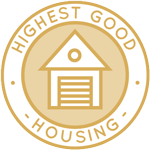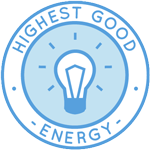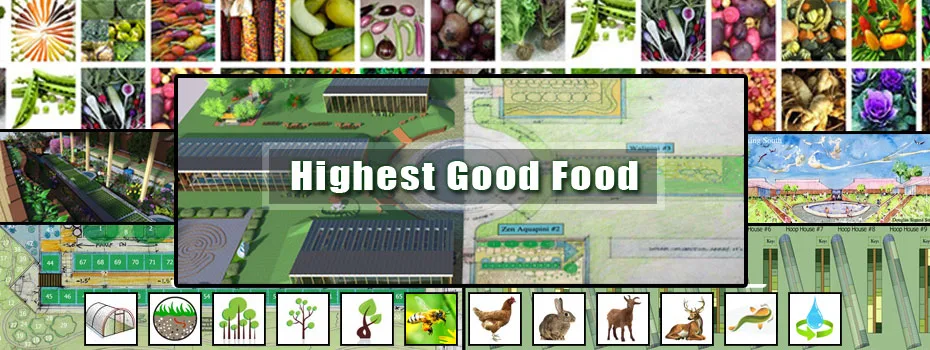
Highest Good Food Infrastructure
A clear and executable food setup plan is essential to the success of One Community as well as any community that is creating a sustainable long-term solution to address their food requirements. Producing high quality and diverse food by following our Highest Good Food model is a sustainable, efficient, and effective way for us to grow our Community and meet our ever-changing needs as we develop. This page covers everything you will need to know about implementing a short-term to long-term Food Setup Plan. This page is the open source portal to One Community’s entire Food Setup & Implementation process. It contains the following sections related to the Food Setup Plan & Food Infrastructure Implementation:
- Related Pages
- What is Highest Good Food
- Why Highest Good Food
- Highest Good Food Open-Source Portal
- What is the Food Setup Plan
- Why A Food Setup Plan?
- Our Food Self-Sufficiency Transition Plan
- Basic Daily Food Requirement Specifics
- Our Food Setup Roll-out Plan Overview
- Food Self-sufficiency Implementation Details For 10 – 20 People
- Food Self-sufficiency Implementation Details For 20 – 50 People
- Food Self-sufficiency Implementation Details For 50 – 100 People
- Food Self-sufficiency Implementation Details For 100 – 400 People
- Food Self-sufficiency Implementation Details For 400+ People
- Resources
- Summary
- FAQ
RELATED PAGES (Click icons for complete pages)
 |  |  |  |  |  |  |  |  | 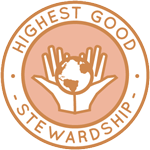 |
WHAT IS HIGHEST GOOD FOOD
We consider Highest Good food to be maximally nutritious, maximally bio-diverse, fresh, duplicable, space and resource efficient, ecologically and individually healthy food that is far superior to anything found in a typical grocery store. We are approaching this so it caters to vegans, vegetarians, and omnivores. We are also integrating it with One Community’s open source and earth-regenerative botanical garden model for those interested in joining the global cooperative of people specifically studying, preserving, sharing, and evolving plant species for The Highest Good of All.
WHY HIGHEST GOOD FOOD
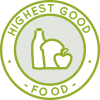 The food and related infrastructure components we are open source developing are purposed to positively and permanently transform the world because they meet the needs of individuals while also benefiting all of humanity, the planet, and all life on it. They do this through:
The food and related infrastructure components we are open source developing are purposed to positively and permanently transform the world because they meet the needs of individuals while also benefiting all of humanity, the planet, and all life on it. They do this through:
- Educating people
- Saving people money
- Conscious stewardship
- Improving people’s health
- Improving global biodiversity
- Providing a better eating experience
- Providing economic opportunity through sharing new foods
- Providing more free time when maintained collaboratively
- Eliminating the need for pesticides, fungicides, and herbicides
- Combining with One Community’s self-sufficient and self-replicating teacher/demonstration community, village, and city model to increase global food security and address global hunger
WAYS TO CONTRIBUTE TO EVOLVING THIS SUSTAINABILITY COMPONENT WITH US
SUGGESTIONS | CONSULTING | MEMBERSHIP | OTHER OPTIONS
CONSULTANTS ON THE HIGHEST GOOD FOOD DESIGNS
Avery Ellis: Aquaponics Specialist and owner/operator of Integrated Aquaponics
Bear Stauss: Horticulturalist and Landscape Design/Recreation Area Management Specialist
Benjamin Sessions: Strategic Sales and Real Estate Development Entrepreneur and Food Connoisseur
Bupesh Seethala: Architectural Drafter & Designer, BS Electrical Engineering (BupeshSeethala.com)
Charles McLean: Architecture & Urban Agriculture Designer, Professor, and owner of OM Greengroup
David Sweet: Architect (DSweet.biz)
Douglas Simms Stenhouse: Architect and Water Color Artist (see: transparentwatercolor.com)
Kim Braman: Apiary and Beekeeping Expert
Ron Payne: HVAC / Thermal Designer, Mechanical Engineer
Sandra Sellani: Business Author, Speaker, Consultant, and Vegan Chef
Zdenek Jurik: P.E. Structural, Civil and Mechanical Engineer and founder of ABC Engineering
HIGHEST GOOD FOOD OPEN SOURCE PORTAL
Highest Good food is an approach to global transformation through open source and free-sharing how to grow food that is maximally nutritious, maximally bio-diverse, fresh, space and resource efficient, ecologically and individually healthy, and far beyond anything found in a typical grocery store. The following sections will evolve and expand indefinitely with open source content that covers all aspects needed for duplicating of One Community’s food infrastructure. This can be done in part or as a whole and includes the following areas and open source resources to facilitate the process:
WHAT IS THE FOOD SETUP PLAN?
The Food Setup Plan is designed and purposed to support from 20 people all the way up to 500 people and more as it develops. With proper planning, you can utilize this sustainable food setup plan to create a variety of different methods of growing your own food. This will enable you to eat plenty of good food all year around and continue to expand your gardens, crops, animals, and so forth to accommodate your growing needs and desires. Over time, there can even be a surplus of food that can be sold locally as an income source.
We consider our Highest Good Food Setup to be creating food that is far superior to anything found in a typical grocery store. We are approaching our food setup so that it caters to vegans, vegetarians, and omnivores. We are also integrating it with One Community’s open source and earth-regenerative botanical garden model for those interested in joining the global cooperative of people specifically studying, preserving, sharing, and evolving plant species for The Highest Good of All.
Our comprehensive Food Setup Plan, in total, will primarily involve utilization of these very important methods:
- Bulk Food Purchasing & Preparation
- Large-Scale Soil Amendment
- Large-Scale Gardening
- Hoop Houses
- Food Forest Creation
- Walipini, Aquapini, and Zen Aquapini’s
- Botanical Gardens
- Ethical Raising of Goats, Rabbits, and Chickens
- Aquaculture & Aquaponics
- Apiary / Bee Yard
WHY A FOOD SETUP PLAN?
One Community has chosen this Food Setup Plan for three primary reasons:
- Although the initial phases of creating the food infrastructure is fairly time-intensive, in the long run, having our own food infrastructure and using this Food Setup Plan will save a massive amount of time
- Although the initial investment to build our Food Infrastructure as outlined in this Food Setup Plan is high, it saves a lot of money in the long run compared to buying food from other sources
- This Food Setup Plan will create the largest variety of bio-diverse, nutritious, delicious food that anyone has likely ever experienced before. We have anywhere from 8 to 25 different varieties of each and every fruit and vegetable that we are planning to grow! Grocery stores typically stock the same 2 to 4 varieties, some of which are seasonal
Our Food Self-Sufficiency Transition Plan
 A food self-sufficiency transition plan is purposed to provide a specific road map for people to buy and prepare delicious, healthy, and affordable food while establishing the necessary infrastructure to produce their own food. To meet our open source and maximally adaptable and implementable global transformation goals, this food self-sufficiency transition plan has been created with the following goals:
A food self-sufficiency transition plan is purposed to provide a specific road map for people to buy and prepare delicious, healthy, and affordable food while establishing the necessary infrastructure to produce their own food. To meet our open source and maximally adaptable and implementable global transformation goals, this food self-sufficiency transition plan has been created with the following goals:
- Less than $13 per person per day cost
- Includes both a temporary and permanent kitchen strategy for food preparation
- To provide a cooking strategy that is easily modified and scalable depending on the size of the group
- To provide a meal plan that provides whole-food based flavorful dishes from around the world and caters to both a vegan and omnivore diet



Why A Food Self-Sufficiency Transition Plan?
This food self-sufficiency transition plan is purposed to be useful for any situation where people are looking to establish a temporary kitchen and prepare food for large groups of people over long periods of time. Most people like the idea of growing their own food but haven’t considered the details of what would be necessary to actually achieve self-sufficiency. As part of our global transformation goals, an open source transition plan that addresses the steps leading to self-sufficiency for sustainable teacher/demonstration communities, villages, and cities is absolutely essential.
Basic Daily Food Requirement Specifics
Our daily food requirements per-person are broken down as such:
- 2,000 – 3,500 calories (kCal)
- 1 – 2 gallons of fresh, clean water
- As much variety of raw and cooked food as realistically possible at each stage of development
These figures account for the variety of activity levels expected among the pioneer team, as well as the variety of different body types, weights, diets, and metabolisms. Team members who are focusing primarily on manual labor will definitely be eating more calories, while team members who are focused more on sedentary duties such as laundry, cooking, cleaning, taking care of children, etc. will be eating predictably less calories.
Our team will also be in constant need of fresh, clean water to keep us well-hydrated throughout our labor-intensive workloads. This can be achieved by running well water through a water filter to remove heavy minerals.
Our Food Setup Roll-out Plan Overview
Our comprehensive food setup roll-out plan will be executed as follows:
- Initial Setup Phase – 10-20 people arrive on the property (4-8 weeks)
- The First Wave – 20-40 more people arrive (up to 50 total people)
- The Second Wave – 20-60 more people arrive (up to 100 total people)
- The First Five Years – 100-300 more people arrive (up to 400 total people)
- The Long Term – Many more people arrive (400+ people)
Phase I & Phase II Food Infrastructure
Throughout the One Community website and on this page, we refer to the food setup process as being specifically “Phase I” or “Phase II.” On this page specifically, Phase I and Phase II implementation details will be organized throughout the food rollout plan.
LABOR PROJECTIONS, TRACKING, AND UPDATING
 Labor projections are all educated estimates, only for items begun after the first team moves to the property, and based on individuals who can physically and efficiently carry out the tasks. Total hours will be part of community contribution and, in most cases, divided amongst multiple people. The re-evaluation and redefinition of these projections will be ongoing and tracked using our custom software until tasks are completed and a definitive and final hourly time investment can be assessed and shared for each task. The process of projecting, tracking, and updating labor investment in various tasks will continue indefinitely as part of One Community’s open source contribution to global transformation. Here are the projections:
Labor projections are all educated estimates, only for items begun after the first team moves to the property, and based on individuals who can physically and efficiently carry out the tasks. Total hours will be part of community contribution and, in most cases, divided amongst multiple people. The re-evaluation and redefinition of these projections will be ongoing and tracked using our custom software until tasks are completed and a definitive and final hourly time investment can be assessed and shared for each task. The process of projecting, tracking, and updating labor investment in various tasks will continue indefinitely as part of One Community’s open source contribution to global transformation. Here are the projections:
- Starter house construction (if initially needed): (160 hours)
- Soil profiling and lab related work plus perc testing: (3 hours)
- Initial swale creation: (240 hours initial + ongoing as required)
- Soil preparation and amendment: (100 hours initial + 15 hours/month)
- Orchard irrigation installation: (560 hours)
- Hoop house irrigation installation: (440 hours)
- Open garden irrigation installation: (440 hours)
- Cover crop creation (50 hours)
- Orchard pruning (125 hours)
- Seedling starts (250 hours)
- Hoop house construction (1000 hours)
- Planting of the hoop houses (320 hours)
- Planting of the initial open gardens (320 hours)
- Planting of the initial food forest (128 hours)
- Grafting and planting of fruit/nut trees (20 hours)
- Removal of dead trees and Hugelkultur creation (64 hours)
- Fence installation and green fence planting: (80 hours each)
- Creation of post-survey initial Master Plan: (40 hours)
- Incoming goods organization and inventory planning: (ongoing: 5 hours/wk)
- Computer data entry and open source sharing: (ongoing: 40 hours/wk)
- Video documentation and editing: (ongoing: 80 hours/wk)
- Food menu creation: (80 hours initial + ongoing: 2 hours/wk)
- Bulk food procurement: (8 hours of research and ordering + 1-2 hours/month)
Food Self-sufficiency Implementation Details for 10-20 People
The initial survey team or “landing party” will arrive on the property 4-8 weeks before the Pioneer team arrives. The primary task of this initial survey team in regards to our Food Setup Plan will be:
- Ordering & preparing bulk food for the team
- Constructing the Transition Kitchen
- Ordering materials, tools, large earth-moving equipment, generators, & fuel
- Surveying the Land
- Beginning the Soil Amendment Process
- Site Selection & Soil Assessment For Planting
- Site Preparation & Loosening the Soil
- Constructing the 18 Hoop Houses
- Planting
Here are some highlights taken from the list of bullets above (click each link to read more information):
Ordering Bulk Foods
There realistically won’t be any food for the initial survey team to eat within the first 45 – 60 days of landing on the property, aside from eggs. Therefore, the setup team will be ordering food to be shipped to the property or picked up locally, as well as buying as much locally-grown fresh foods as possible every week. This includes bulk starches like rice, beans, potatoes, grains, & legumes, as well as fruits, vegetables, eggs, dairy products, and meats. The initial setup team will determine very quickly what food works and what doesn’t; what is most cost-effective, easy to prepare, filling, and enjoyable to eat.
Constructing the Transition Kitchen
After construction of the Transition Kitchen, the chef and sous-chef will be able to prepare three meals per day plus snacks for everyone on the team. The Transition Kitchen will enable the initial team as well as the first wave of pioneers to prepare all of the various foods that are being ordered. This transition kitchen will last us until we create our permanent kitchen during Phase II.
Ordering Materials, Tools, Large Earth Moving Equipment, Generators, & Fuel
All of the following earth-working processes require different tools and materials to construct and operate. Some tasks require things like shovels and trowels, while others require massive backhoe’s and bulldozers. The initial setup team will be purchasing all of the tools and materials necessary for each step of the process as outlined below.
Surveying The land
Surveying the land is the first step of the soil amendment process and it will commence during the 1st week of us owning the property and continue intermittently throughout the project even after the initial survey. We will do this for contours and possible increased resolution of the contour map for swale planning and other earthwork, identification of building sites for POD 1 and The Duplicable City Center, and locating water holding tanks and planning other water infrastructure.
Soil Amendment
The One Community soil amendment strategy from our horticulturalist and botanist prepares a property of below-average soil to become a successful growing environment. It covers all aspects of the preparation process from surveying the land and site selection to fencing, grading, cover crop planting, composting and more.
Site Preparation
Once the specific growing sites are designated, the next step is identifying the need for the following (and implementing immediately):
- Swales (will require surveying), grading, leveling, contouring, and rock removal by hand or raking
- Soil preparation and amendment and implementation of short and longterm solutions
- Cover crops sown to increase organic matter (depending on the time of year)
- Orchard pruning (conducted in late winter/early spring February/March, temperature & weather dependent)
- Install protective fencing and/or plant a green fence
- Install irrigation as needed

Tamera Eco Settlement Water Conservation Results: This Took Less Than 4 years
Hoop House Construction
Our goal when arriving on the property is to immediately start large-scale gardening and building ultra-affordable, easy, and fast to construct hoop houses. Once we have acquired all the necessary components locally, ordered UV/IR plastic, amend the soil as mentioned above, and worked through a weekend learning curve of hoop house construction to build the first hoop house, we project that 8 people working in two-person teams should be able to complete the construction of 18 hoop houses in less than 8 weeks.
See the Hoop House Construction and Costs section of the open source hoop house portal for complete details on what a hoop house is, why they are useful, how to build them, how much they cost, smaller options, and more.
Planting
Once the sites have been selected, analyzed, swaled and earth-worked, soil profiled, fenced, irrigation installed, and cover cropped, we are ready to plant. The planting phase will happen in the following ordered steps:
- Seedling starts
- Hoop house construction
- Planting of hoop houses
- Large-scale garden planting
- Planting of the food forest
- Grafting and planting of fruit/nut trees
An earlier planting of cole crops will be followed by other crops. To assure we produce enough food to feed 100 people within 1 year, we will intentionally over plant the open gardens and use this initial planting as a gauge for following years and data collection for the One Community open source botanical garden model. Surplus produce will be preserved for winter use. Complete planting details for the large-scale gardens are included on the large-scale gardens page.
Phase I of the food setup plan will begin with the arrival of the ‘initial setup team’ and continue to expand until it is completed, which will be within the first year on the property. Phase I Food Production is primarily focused on building the foundation of the food infrastructure to easily feed 100+ people with a large variety of different-tasting foods as well as different nutritional profiles to ensure proper nourishment for everyone involved. We are intending on achieving food self-sufficiency by the end of the first year on the property.
Food Self-sufficiency Implementation Details for 20-50 People
 Once the Pioneer team arrives on the property, the plant foods that the initial survey team has planted will likely not be ready for harvest yet. Because of this reality, the Pioneer team will be eating almost entirely bulk foods that we purchase locally which will be prepared on-site in our Transition Kitchen. We can expect to be up to 10% food self-sufficient at this time in our development.
Once the Pioneer team arrives on the property, the plant foods that the initial survey team has planted will likely not be ready for harvest yet. Because of this reality, the Pioneer team will be eating almost entirely bulk foods that we purchase locally which will be prepared on-site in our Transition Kitchen. We can expect to be up to 10% food self-sufficient at this time in our development.
The overall strategy when planning to cook for an average of 50 people a day will be to use our fully-stocked transition kitchen. This will provide equipment that will reduce preparation, cooking, and cleaning times. This is especially important in the case of intentional Communities and self-sufficient teacher/demonstration hubs that may rely on volunteer labor to produce meals.
The ‘first wave’ pioneer team will continue to expand and build on top of the basic amenities that the initial survey team has set up. With regards to our food infrastructure, this will include:
- Planting more foods in the Hoop Houses
- Continued development of the Large-Scale Gardens
- Irrigation details
- Planting trees for creation of the Food Forest
- Basic composting
- Caring for Chickens and Goats
Our energy at this point in our development will best be spent building our infrastructure and planting a variety of foods for the team to eat in the near future. This focus on building our basic food infrastructure will ensure food self-sufficiency as quickly as possible as well as allow for more and more people to live on the property.
We will need to make sure our goats and chickens are taken care of because they will quickly be turning our food waste into fertilizer for our plants. We probably won’t be composting very much at this point, but whatever is compostable will be composted.
Creating the One Community food forest will begin in the first year and continue indefinitely. The creation of swales will help build the water table, renew the land, and turn our property into a lush and abundant foodscape as we implement an on-going process of “swale-mulch-plant” that moves progressively across the landscape until the entire property has been regenerated.
In the case of One Community, the food forest project will also be part of our open source botanical garden model and ultimately expand to involve 100’s of acres functioning as both food production and ultra-abundant wildlife habitat. Complete planting details for the food forest are included on the food forest page.
Specific Food Implementation Details For 20 – 50 People
The primary source of food for the first 50 people will be:
- Bulk foods that we purchase: rice, beans, potatoes, fruits, veggies, & animal products
- Eggs from Chickens
- Possibly milk from Goats
- Anything that we can forage on the property
Our basic foods that we will be purchasing in bulk will be (at the very least): bananas, rice, potatoes, veggies, eggs, dairy, and meats. We can expand our variety of foods if desired, by coming to a decision through the consensus process. Any specific foods that individuals desire to eat that aren’t provided by One Community, for whatever reason, can always be purchased by the individual.
When combined with milk, eggs, and meat from ethical animal husbandry, for those who choose to eat them, we project we can feed all 50 of the initial building team plus an additional 50 interns/scholarship recipients by the end of the first year.
Food Self-sufficiency Implementation Details for 50-100 People
During this phase of our development, 30-60 more people will arrive on the property, bringing our total population between 50 and 100 people.
We will build enough hoop houses and plant enough food to make ourselves about 70% food self-sufficient within 3-4 months of the second wave of people arriving on the property. Combining this with raising goats, chickens, and rabbits, for those who choose to eat them, will provide sufficient food to feed 100+ people by the end of the first year. Our energy at this point in our development will be focused primarily on:
- Continued development of Large-Scale Gardening
- More planting in the Hoop Houses
- Transitioning to setting up our Permanent Kitchen
- Continued development of the Food Forest
- Development of our Apiary/Bee Colony
- Possibly starting to build our Aquapini & Zenapini structures

We will use hoop houses to expand both our early and late growing seasons by establishing seedlings earlier in the spring and growing a second fall crop of leafy greens. This will provide a more efficient, affordable, and effective production plan than simply growing outdoors. Foods that will do well in hoop houses include potatoes, onions, beets, carrots, tomatoes, cabbage, etc. Any foods grown this way will also be accessions as part of our open source botanical garden model. This large-scale gardening plan will also:
- Identify the species of plants that will do best in a specific area
- Providing sufficient seeds to double the garden size by the next year
- Providing food diversity far superior to what is available in the grocery store
- Specifically providing foods for fresh-eating, canning, pickling, freezing, and drying
We will also be transitioning to our permanent kitchen at this time. We will be using our temporary kitchen during this transition to continue to provide our daily meals.

Click to go straight to the City Center Kitchen page
The Aquapini & Walipini structures may or may not begin to be built during this phase of our development, depending on how far along we are.
Specific Food Implementation Details For 50 – 100 People
The primary source of food for the first 100 people will be:
- Bulk foods that we purchase: rice, beans, potatoes, fruits, veggies, & animal products
- Harvested foods from the Hoop Houses & Large-Scale Gardens
- Eggs from Chickens
- Milk from Goats
- Anything that we can forage on the property
At this point in our development, we can expect to be up to 70% self-sufficient. The rest of our food needs will be supplied from our bulk foods. We will definitely have plenty of eggs by this point, and our goats will begin to produce milk as well.
Food Self-sufficiency Implementation Details for 100 – 400 People
The first five years of food creation and management on the property will definitely be interesting, fun, and challenging. At this time in our development, we can expect to be up to 90% food self-sufficient. We will close the gap to become 100% food self-sufficient over the following months and years with the growing & production of specialty items like spices, flours, extracts, making our own oils, and other miscellaneous items that we were previously buying.
By the second year we will continue to increase our annual yield from large-scale gardening strategy and expansion and development of the One Community food forest. Our first-year experience with the hoop houses and gardening will build the foundation for production from the second year forward to meet any additional food needs for ourselves and all our guests. The quantities grown are limited only by our labor input and our ability to both ward off and allow hungry critters their fair share.
During this stage of our development, our energy will be focused primarily on:
- Building our Aquapini & Zenapini structures
- Continued development of Large-Scale Gardening
- Continuing planting in the Hoop Houses
- Large-scale development of the Food Forest
- Development of our Apiary/Bee Colony
- Development of our animals and livestock
The construction of Phase II structures will begin at this time, if it hasn’t already begun before this time. The Phase II food structures are larger and more permanent structures, such as the aquapini and walipini structures. Once we start building these structures, the first two are estimated to take no more than 6 months to build and test and another 2 months or so to be producing food. All six structures should be able to be completed within a year.
With the completion of our Phase II food structures, providing enough food for everyone, along with even more food diversity, will be easily attainable. Below is a general overview of the Phase II structures.
Aquapini, Walipini, & Zenapini Overview
The One Community Walipini, Aquapini, and Zen Aquapini structures will adhere to our botanical garden guidelines while demonstrating 6 distinctly different growing zones that will produce a combination of quality, volume, and food diversity that significantly exceeds what is available in most grocery stores. With traditional methods, one person working full-time on food production can produce enough food to feed 30; with aquaponics that same person can produce enough food to feed 300. For more general information on these structures, visit the Aquapini and Walipini Open Source Project-launch Blueprinting Hub.
The following links will take you directly to the following information on the Aquapini & Walipini page:
- Aquapini, Walipini, and Zen Aquapini Planting and Harvesting Overview
- Large-scale Production Tropical Aquapini planting and harvesting details
- Walipini #1: Frost-free Arid Zone Desert House planting and harvesting details
- Walipini #2: Borderline Subtropical House planting and harvesting details
- Walipini #3: Tropical House planting and harvesting details
- Zen Aquapini #1: Cloud Forest House planting and harvesting details
- Zen Aquapini #2: Tropical Moist House planting and harvesting details
- Attracting Pollinators
CLICK IMAGES FOR COMPLETE DETAILS | ||
WAYS TO CONTRIBUTE TO EVOLVING THIS SUSTAINABILITY COMPONENT WITH US
SUGGESTIONS | CONSULTING | MEMBERSHIP | OTHER OPTIONS
CLICK HERE TO HELP US FINISH THE OPEN SOURCE DESIGNS FOR THESE STRUCTURES
The six initial food production structures of One Community are designed to be duplicated as standalone structures or as a complete village food infrastructure set. The systems will consist of a large-scale food production aquapini (LSAQ), 2 different “backyard version” zen aquapini designs (Z1 and Z2), and 3 separate maximally-affordable Walipini Greenhouses (W1, W2, and W3). Combined they will provide:
- Unparalleled food diversity
- 6 unique aesthetic environments (LSAQ) (Z1 and Z2) (W1, W2, and W3)
- Over 11,500 square feet (1,068 sq meters) of year-round growing space
- Artistic designs
- ADA Accessibility
- Multi-functional use
- Central amphitheater space
- Water collection off of structures
- Inclusion of Aquaculture
Aquapini & Zenapini Summary
Realistically, our initial food yields will be considerably less than the numbers shown here, since it is the first iteration of this model. We will definitely run into various snags, hiccups, and opportunities for improvement. Because of this, our expectations for food output with these structures, in the beginning, will be fairly low. Also, the types of foods we will be growing in the beginning will not be very calorie-dense; cabbage, spinach, lettuce, peppers, tomatoes, etc. In the long run, we will definitely work out all the bugs and be producing thousands and thousands of pounds of both high and low-calorie foods with these structures.
Specific Food Implementation Details For 100-400 People
The primary source of food for the first 100-400 people will be:
- Bulk foods that we purchase: rice, beans, potatoes, fruits, veggies, & animal products
- Harvested foods from the Hoop Houses & Large-Scale Gardens
- Food from the Aquapini, Walipini, & Zenapini structures
- Eggs from Chickens & milk from Goats
- Ethical harvesting of Rabbits for meat
- Ethical harvesting of Aquaculture
- Honey from the Apiary
- Anything that we can forage on the property
At this point in our development, we can expect to be between 90% and 100% food self-sufficient. The rest of our food needs will be supplied from our bulk foods.

Click this image to see our Aquaculture Page
Food Self-sufficiency Implementation Details for 400+ People
In the long term, One Community will be feeding 400+ full-time residents as well as 150+ visitors at a time. Feeding 550 people is no small task; it’s a lot of food! The reality of the situation is that reliably meeting or exceeding the caloric needs of 550 people every single day purely through our own sustainable food infrastructure is challenging. However, we definitely feel that we can accomplish this with time.
Food Projections for Feeding 550 People
Our caloric intake among residents will vary somewhere between 2,000 and 3,500, depending on a variety of factors. If we take an average of 2,500 calories per person, we can figure out how many calories we will need to supply to be self-sustainable. Here are some healthy projections of what it will take to feed 550 people:
~2,500 calories x 550 people = ~1,375,000 calories per day
This is a massive amount of food to supply every day. Obviously, we wouldn’t be eating any one food item exclusively. However, to get a good idea of what it would take to supply this quantity of food, as an example, we would need any one of the following:
- 15,277 bananas @ 90 calories each
- 8,593 cooked potatoes @ 160 calories each
- 6,395 cups of cooked rice @ 215 calories per cup
- 5,978 cups of cooked black beans @ 230 calories per cup
- 6,250 cups of cooked quinoa @ 220 calories per cup
- 17,628 chicken eggs @ 78 calories per egg
- 611 gallons of goats milk @ 2,250 calories per gallon
- 1,729 rabbits @ 795 calories per pound & 1 pound per rabbit
*For the sake of these calculations, low-calorie vegetables have been left out, as they typically make up less than 5% of the daily caloric intake of any person.
For some large-scale recipe calculations, be sure to check out our Food Self-Sufficiency Transition Plan.
Resources
- Open Source Large-scale Soil Amendment Hub
- Open Source Food Forest Creation Hub
- Open Source Large-scale Gardening Hub
- Open Source Botanical Garden Creation Hub
- Open Source Hoop House Creation Hub
- Open Source Aquapini and Walipini Creation Hub
- Food Self-Sufficiency Transition Plan
Summary
 One Community wants to help people to grow their own high quality and diverse food. We believe if we can make this easy enough, affordable enough, and attractive enough, it will provide a clear path to increasing health, biodiversity, and individual and global food security. Our Food Setup Plan is a sure way to create a lasting impact in our communities and our lives. This plan allows us all to live a healthier, happier, more enriching life when it comes to food and true Earth stewardship.
One Community wants to help people to grow their own high quality and diverse food. We believe if we can make this easy enough, affordable enough, and attractive enough, it will provide a clear path to increasing health, biodiversity, and individual and global food security. Our Food Setup Plan is a sure way to create a lasting impact in our communities and our lives. This plan allows us all to live a healthier, happier, more enriching life when it comes to food and true Earth stewardship.
Frequently Answered Questions
Q: Is One Community going to be a vegetarian community?
The One Community team consists of vegans, vegetarians, and omnivores. In accordance with our philosophy for The Highest Good of All we are maintaining a non-idealogical approach to food choices. That said, also in accordance with this philosophy, we will only support and consume food items that are ethically and sustainably-raised, managed, and produced. The consensus process will be used to decide the evolution of the One Community food plan.
Q: How do you intend to produce spices, mill grain for flour, cooking oil, etc. etc.
To us, “100% food sustainability” means we will demonstrate and open source share a model that doesn’t need external food sources. Having achieved this, what we produce internally versus choosing to buy will be decided through the consensus process.
Q: What is One Community’s stance on pesticides, herbicides, and fungicides?
If it is not safe to eat, we will not be spraying it on our food.
Q: Can people choose not to eat in the group dining hall?
Yes, the Duplicable City Center will provide group dining space and the kitchen, where people choose to eat is up to the individual.
Q: Would we be allowed to have a hot plate stove (single burner)/microwave/toaster oven in our private residence if we wished to cook apart from the rest of the community from time to time?
Yes, people can supply their individual residences with these items if they want to.
Q: Do you plan to raise cows or other large grazing animals for milk or food.
Probably not due to the sustainability issues with this approach to food. This could however change if agreed upon through the consensus process.
Q: What if I want something that isn’t on the community menu?
The community menu will be agreed upon through the consensus process. If a person wanted something not included on that menu, then they would be welcome to purchase and provide it for themselves.
Q: What if you are unable to meet your timelines for food self-sustainability?
We have funds built into our business plan to provide food for an additional year if necessary.
Q: I’m vegetarian/vegan, would I have to participate in any part of the process or raising animals for food and/or eating/cooking them?
No, you would not have to participate in any aspect of One Community’s food diversity that didn’t agree with your personal beliefs and preferences.
 One Community
One Community










